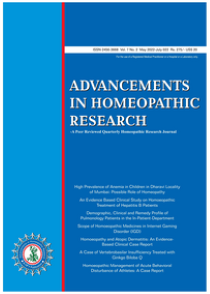Chronic Kidney Disease: A Case Series (Part 7)
DOI:
https://doi.org/10.48165/ahr.2025.10.2.4Keywords:
Haemodialysis (HD), peritoneal dialysis (PD), chronic kidney disease (CKD), chronic renal failure (CRF), end stage renal disease (ESRD), serum urea, blood urea nitrogen (BUN), serum creatinine, estimated glomerular filtration rate (eGFR), renal transplant, homoeopathic treatmentAbstract
In their previous series of six publications, Gupta et. al. demonstrated that patients of chronic kidney disease (CKD) and acute renal failure (ARF) can be successfully managed by homoeopathic medicines. This seventh case series is on successful management of CKD patients by maintaining their serum creatinine level and eGFR within a reasonable range, delaying further deterioration and improving their quality of life for a considerable period of time without haemodialysis. The first case in this series is of 68-year old hypertensive male suffering from chronic renal failure with follow up of about 4 years. His S. Creatinine, Urea level reduced gradually and became normal with homoeopathic treatment without dialysis. His eGFR also increased and he became clinically asymptomatic. The second case is of a 42- year old hypertensive, nondiabetic female. Her S. creatinine and eGFR was maintained for more than 3 years. The third patient is a 55-year old hypertensive, nondiabetic, anaemic female. Her S. Creatinine and S. Urea gradually reduced and eGFR improved with homoeopathic treatment without dialysis. Her treatment is still continued.
References
Gupta G, et al. A clinical study on the role of homoeopathic medicines in chronic renal failure patients assessed by estimated glomerular filtration rate (eGFR). National Journal of Homoeopathy. 2015;17(6):14–29.
Gupta G, et al. Chronic kidney disease: A case series. Advancements in Homoeopathic Research. 2023;8(2):29–34.
Gupta G, et al. Chronic kidney disease: A case series (Part 2). Advancements in Homoeopathic Research. 2023;8(3):44–9.
Gupta G, et al. Acute renal failure: A case series (Part 3). Advancements in Homoeopathic Research. 2023;8(4):33–8.
Gupta G, et al. Chronic kidney disease: A case series (Part 4). Advancements in Homoeopathic Research. 2024;9(2):31–6.
Gupta G, et al. Chronic kidney disease: A case series (Part 5). Advancements in Homoeopathic Research. 2024;9(3):27–31.
Gupta G, et al. Chronic kidney disease: A case series (Part 6). Advancements in Homoeopathic Research. 2024;9(4):20–5.
Murphy R. Homoeopathic Medical Repertory. 2nd ed. New Delhi: B. Jain Publishers Pvt. Ltd.; 1996. p. 421.
Boericke W. Boericke’s New Manual of Homeopathic Materia Medica with Repertory. 3rd revised ed. New Delhi: B. Jain Publishers Pvt. Ltd.; 2008. p. 56–58, 60–61, 72–75, 217, 422–425, 489–492, 1089.
Kent JT. Lectures on Homoeopathic Materia Medica. New Delhi: B. Jain Publishers (P) Ltd.; 2009. p. 115–122, 148–171, 766–772.
Singh S, et al. Homoeopathy in the management of chronic kidney disease – A narrative review. Indian J Res Homoeopathy. 2022;16(3):216–23.




